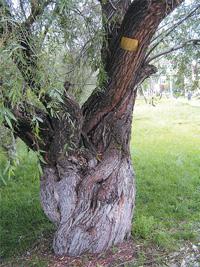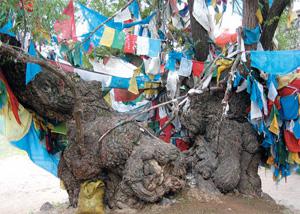Trees in Lhasa
2008-09-25

Trees are flourishing in Lhasa wherever the history exists. There is such a man.
He has already been through customs after his annual trek to Lhasa, which he has been doing for over twenty years in succession to visit his tree. Although he has been making this journey for so long, it is neither to visit friends or family, nor is it his hometown. It is a tree that is tied so profoundly to his heart. When the wind blows fiercely on the bare tree and winter snow falls, he stands before the tree with tears of joy in his eyes.
It is a rather remote area, but rich with monuments. He keeps on and on, without stopping. He claims nothing must jeopardize his visit to the tree in Lhasa and declares that if one day he is unable to walk any more, he will crawl to visit the tree.
He wishes he could be a tree in Lhasa-maybe an apple tree in blossom.
This is a graveyard with many historic trees. When the spring comes, these blossoming apple trees seem like white clouds cruising in the sky, in unison with the clouds.
What is it that causes him to have such deep affection toward these trees in Lhasa?
Eventually, I was told that his loved one was buried beneath the trees. Although I know who the buried persons are, I prefer not to mention them, but I cherish their stories as precious and beautiful tokens and perpetually hold them deep in my memory, from which they will always return to my mind from time to time. I believe, by doing so, the stories I write will always find their origins in beauty, regardless of what happens in the stories.
Coming to terms with the past does not mean that we will not repeat our past mistakes. Sometimes, those socalled mistakes are not worth remembering. Because these things can be painful, it is wise to keep ones mouth shut about them and talk instead about the trees in Lhasa.

Dzongyab Park lies right behind the Potala Palace, surrounded by trees. Looking at these trees, they touch the sky and dress in a glamorous green gauze handkerchief revealing their graceful shapes. But some of them have short figures; bent like a hook in a totally ugly contour, while the others seem old enough and yet unwilling to open their eyes. Their bodies are completely covered with lichen over which worms and wild flowers are creeping. It seems that they were all planted here longer than those people buried beneath them. We may say mankind is here due to their existence or we may also observe that they and human beings appeared simultaneously on the land. They are the willows pictured by the famous artist Mr. Tang in his painting entitled Archaic Willows in Lhasa. A year ago, Mr. Tang worked on a newspaper. He gave me an album of his paintings and asked for my comments. Having little knowledge about the archaic willows in Lhasa at that time (even through I had experienced in drawing pictures for several years), I decided to presented this album to my friend Mr. Zhou who was a distinguished writer serving in the army headquarters of Chengdu in Sichuan Province. The reason was that I was very impressed by Mr. Zhous writing, which matched perfectively the unique features of the willows in Lhasa. Besides, Mr. Zhou has serviced in Lhasa Military Headquarter for several years and I believed he was profoundly attached to the ancient willows of Lhasa. Nevertheless, before long a commentary focusing on the album appeared in the newspapers, in which the news about the inauguration of Mr. Tangs new position was announced. I started to realize how the two men had naturally acquired an affection and romantic attachment to Lhasa and its trees.

Here the so-called “archaic willows” are actually named “Tang willows” by Lhasa people.
Though the Tang willows in Lhasa may not appear as charming as those of the hinterland, they still look striking and grow vigorously. At least, these willows are steeped in history and dare to resist a harsh environment. Their rate of growth is much closer to the natural rate for the local environment. In this harsh climate, the willows have to minimize their basic needs for oxygen. When you have basked yourself in sunlight for long time and then move under the Tang willows, you immediately feel such a release and it seems a load is taken from your shoulders.
In particular, those deep-rooted willows along riverbanks always impress you as if they have gone through too many tragedies over the years. They appear to have hollow stomachs and their outer branches hang down to the water as though frolicking with the fish. All that is left is the hollow, disfigured but vigorous trunks with their zigzag dragon-like roots deep in the mud and stones along the riverside. Nevertheless, there are still some leaves and twigs flourishing like a brave eagle flying toward the gold peak of the Potala Palace. They seemingly dare to contest with the poplars living in the Bandajiling Desert. They can survive for a thousand years. Sometimes, even if they are dead, they never rot. In a way they are the elite of the plateau with their perseverance and muscularity.

Tang willows are rather common everywhere in Lhasa, particularly in monasteries and ancient sites. Whenever observing them, I feel my body is suddenly relieved from the hot summer, like the pilgrims encounter with Princess Wencheng. Sometimes I like to use them to take photos. Whenever I glimpse them, the spectacular oil paintings of Isaak Levitan appear in my mind. Such miracles always happen if photographing them as the background to a picture. Even if the only part of a tree left its trunk, the buds still form each year. Observing them, you are easily attracted and your mind is filled with images of people passing by and various events happening. Though these people and events might not directly relate to the willows, local peoples passionate affection for them makes them an integral part of Lhasa. This city differs from others by inspiring such sentiment and affection amongst its people. Lhasa resembles these trees in its picturesque quality that you will never forget even though you are far away.

In the Norbulingka, I encounter an unknown variety of trees standing beside the Summer Palace. The trees leaves look like those of ficus carica linn (a fig tree). Enormous red fruits hang down and many have fallen to color the ground red. That such a tree could survive on the plateau is a miracle. I first see it at noon. The sun is shinning directly on the top of my head and also on the almost transparent fruit, causing its sunlitreflection to almost dazzle me. This absolutely captivating picture came as a revelation. Nevertheless, the tree is alone. A short distance away, crowds of people are gathered to watch a Tibetan opera performance, totally forgetting the existence of this unique tree. Can you imagine how he (or she?), a living being who perhaps dreams of a sweet life, would feel when he hears this laughter and applause that is not for him? He may well think it is not a plum time for him to be living. I pick up a fruit and smell its fragrance. I ask myself whether or not I was the first person to notice this tree. At least, I stand in front of it and watch it sway in the breeze. In my mind I hear it say to me: “I am a tree, the tree of the divinities, but lonelier than them.”

Virtually, all people in Lhasa love trees. This is so obvious nobody could doubt it. Nonetheless, they never talk about them. Whenever and wherever you see the trees in Lhasa, you will easily find these aged trees are always covered with scripture banners and Kardas, while small monumental plates are erected in front of them with the name and year of planting. Obviously, it signifies the reverence and loyalty of Lhasa people toward the trees. The General Commander Tan Guanshan is a great role model for treelovers. In Lhasa, General Tan introduced a great variety of trees. I never met him, but I saw many of his trees in Lhasa. In the Military Museum in Beijing, it is not hard to find photos of General Tan. Many of them show General Tan holding a big shovel in his hands. He looks like an authentic farmer and his shirt is wet with his sweat. In the crowd, I could not hear any discussion about why it was necessary. Rather there was a feeling of being on the scene and planting trees together with General Tan. Year after year, the trees in Lhasa have continued to survive, struggle, and grow... and each survival touches the heart of General Tan. As time passes, they are rooted deeper in the earth, shooting up, blossoming, and yielding abundant fruits. Trees grow up in Lhasa, and spread to Nyingchi, Lhokar, and Shigatse. Amongst these, one special tree to which I A willow in Lhasa.

am always attracted is the apple tree. Why? It is because in truth the former bleak and desolate plateau has gradually been turned into an apple orchard by General Tan. That is also why history records his name.
Once at a conference, I heard people describe how General Tan had tried hard to transplant a mandarin tree from his home province (Hunan) to Lhasa. Due to the inappropriate climate, his attempt failed. He has my sympathy.
However, if he were alive today, he would surely burst with joy on seeing the prosperity of his trees in Lhasa.
Nowadays, Lhasa is replete with various kinds of fruit trees, not only including mandarin, but also pear, peach, and grapes as well. Generally, fruit trees are flourishing in Lhasa and even miniature gardens are planted with fruit trees. On seeing them, you forget that you are actually on the plateau rather than your own home somewhere outside Tibet.

Groups of trees are spontaneously appearing around the Lhasa Railway Station. Apparently, these trees only arrived three days before I saw them.
Whenever you see this abundance of trees, you raise a sense of nostalgia for so many events that happened in Lhasa. There are many varieties: salix matsudanan cv umbraculi (Chinese Willow), betula platphylla suk (birch), poplar, phoenix tree, cypress, and others. They reach straight to the sky and in autumn their leaves turn red. If there was only one it might not attract my attention but seeing the many trees here gives me great comfort. They are surrounded by luxuriant grass and colorful wild flowers. In strong sunlight the trees appear intensely green and elegant to my eyes.
It is acknowledged to be inconceivably hard for a tree to survive in Lhasa. However, once it takes root and begins to grow it is possible for it to grow into a giant tree that dares to resist not only harsh winds and fierce storms, but also the freezing snow. Eventually, it becomes a divinity amongst the group of trees. Often, my soul is captured by these divinities because they are surrounding me and unfortunately I may not know all their names. I wish I could plant a divine tree deep in my heart. This tree would let me keep his name in my mind, and make me think about him all the time in my endless imagination and deference.
All a sudden, on a day when I forget I am still in Lhasa and, just like the tourists, I see so many charming and captivating trees filling the city and standing on Yuthok Street. They are incredibly impressive, just like so many attractive cranes. Obviously, these are imported trees and not familiar either to me or to Lhasa, let alone having any regard for the city or me. Nonetheless, when I saw them my eyes shone. By living in Lhasa, they are facing less hardship than trees did in the past and may experience few setbacks. They may devote less effort but share more happiness and spend their lives enjoying more flourishing growth. No matter how it happens, their opportunities and fortunes will no doubt to be enough to not only show the capacity, strength and pride of the city, but also demonstrate the successful implementation of the peoples ideology and their policies for the city. A tree might fall someday, but it is just the life of a tree to grow up, die and be reborn. Only when he meets and overcomes adversity will he grow up to be a giant. I have no idea when these trees were planted on the sidewalks of Yuthok Street. Nonetheless, they are standing there in orderly rows in the sunlight. When the dawn comes, I see a new Lhasa and its new life. This holy land with its distinctive seasons will never again fear of the extremes of winter. Though some boughs of a tree branch might wither but please do not be sad. Just leave the tree alone and in time, before your eyes, there will be a forest where you can hear the birds singing. You may even feel more courage and confidence. Eventually, nature does influence you. While myriads of trees are extending their vital energy throughout the seasons, their individual souls are vigorously singing their love songs...
Have you ever heard it while you were sheltering under a tree?
